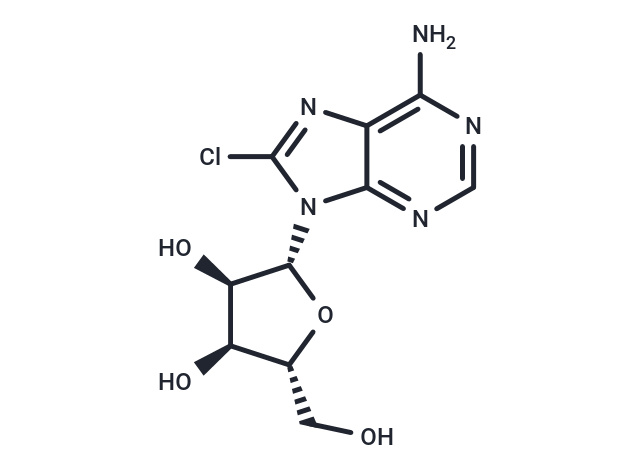- Remove All
 Your shopping cart is currently empty
Your shopping cart is currently empty
8-Chloroadenosine
8-Chloroadenosine (NSC-354258) is a 5' AMP-activated protein kinase agonist potentially for the treatment of chronic lymphocytic leukemia. 8-chloroadenosine activity is associated with inhibition of the mTOR pathway.8-Chloroadenosine (NSC-354258) is a nucleoside analog; metabolized in vivo to 8-Chloro-ATP. Incorporates into RNA during transcription and inhibits RNA synthesis. Exhibits cytotoxicity in MM.1S, RPMI-8226, and U266 cancer cell lines; induces G2/M cell cycle arrest and mitotic catastrophe in A549 and H1299 cells. 8-Chloroadenosine (NSC-354258) has been shown to deplete ATP and inhibit tumor growth in hematological malignancies as well as in lung and breast cancer cell lines.

8-Chloroadenosine
| Pack Size | Price | Availability | Quantity |
|---|---|---|---|
| 1 mg | $30 | In Stock | |
| 5 mg | $123 | In Stock | |
| 10 mg | $198 | In Stock | |
| 25 mg | $348 | In Stock | |
| 50 mg | $519 | In Stock | |
| 100 mg | $738 | In Stock | |
| 500 mg | $1,480 | In Stock | |
| 1 mL x 10 mM (in DMSO) | $169 | In Stock |
Product Introduction
| Description | 8-Chloroadenosine (NSC-354258) is a 5' AMP-activated protein kinase agonist potentially for the treatment of chronic lymphocytic leukemia. 8-chloroadenosine activity is associated with inhibition of the mTOR pathway.8-Chloroadenosine (NSC-354258) is a nucleoside analog; metabolized in vivo to 8-Chloro-ATP. Incorporates into RNA during transcription and inhibits RNA synthesis. Exhibits cytotoxicity in MM.1S, RPMI-8226, and U266 cancer cell lines; induces G2/M cell cycle arrest and mitotic catastrophe in A549 and H1299 cells. 8-Chloroadenosine (NSC-354258) has been shown to deplete ATP and inhibit tumor growth in hematological malignancies as well as in lung and breast cancer cell lines. |
| Alias | NSC-354258, NSC354258, NSC 354258, 8-Cl-Ado |
| Molecular Weight | 301.69 |
| Formula | C10H12ClN5O4 |
| Cas No. | 34408-14-5 |
| Smiles | ClC=1N(C=2C(N1)=C(N)N=CN2)[C@@H]3O[C@H](CO)[C@@H](O)[C@H]3O |
| Relative Density. | 2.19 g/cm3 |
| Storage | Powder: -20°C for 3 years | In solvent: -80°C for 1 year | Shipping with blue ice. | |||||||||||||||||||||||||||||||||||
| Solubility Information | DMSO: 65 mg/mL (215.45 mM), Sonication is recommended. | |||||||||||||||||||||||||||||||||||
Solution Preparation Table | ||||||||||||||||||||||||||||||||||||
DMSO
| ||||||||||||||||||||||||||||||||||||
Calculator
In Vivo Formulation Calculator (Clear solution)
Dose Conversion
Tech Support

Copyright © 2015-2025 TargetMol Chemicals Inc. All Rights Reserved.



